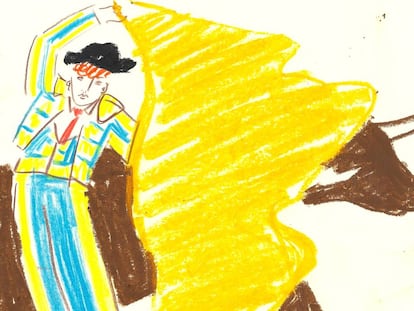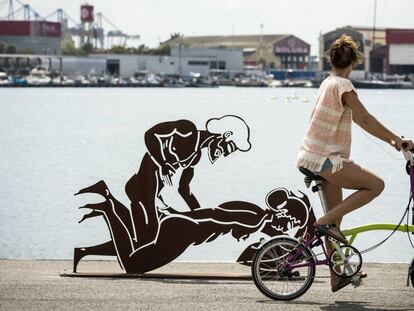Doris Salcedo, the Colombian artist who melted 37 tons of FARC weapons
EL PAÍS SEMANAL talked to one of the most influential artists in Latin America about ‘Fragments,’ her plea for enduring peace in her country, and the power of art to inspire social change
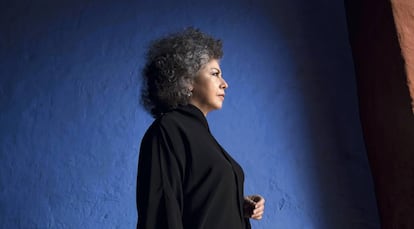
“With my burned hand, I write about the nature of fire...” The quote is from Gustave Flaubert but it is one that Colombian artist Doris Salcedo is very familiar with. After a lifetime of turning our indifferent gaze towards the world’s oppressed, she knows all about how hot the flames get and the extent of the damage they wreak. She knows the art works slowly: it is a transmission belt created in the present to warn new generations about the future. Not that she minds. She takes it in her stride. It strengthens her defiance.
Her latest artwork, Fragmentos (Fragments), opened in Bogotá on December 10. It is a museum whose entire floor consists of the melted remains of 37 tons of decommissioned weapons turned over by the Revolutionary Armed Forces of Colombia, otherwise known as the FARC. It is another milestone in the career of this 60-year-old Colombian, who is the most highly esteemed and widely recognized Latin American artist in the world.
The peace agreement between the Colombian government and the guerilla forces included the creation of three artworks that would keep the conflict that paralyzed development and reconciliation for 70 years from being forgotten. The locations for these pieces would be Havana, where the peace agreement was signed in 2017, New York and Bogotá, the Colombian capital which suffered the bloody consequences of the conflict for years.
Our ignorance is not innocent: we choose not to know
“It’s an anti-monument,” says Salcedo about her work. “The first thing that occurred to me when they asked me to accept the commission was to say no. I didn’t want to work with material that had caused so much pain. I decided I wouldn’t do it but I changed my mind. I understood that the problem was the way it was put to me. I didn’t think the weapons should be made into a monument. I chucked that notion out. I couldn’t construct a hierarchical artwork because we are not looking at a single version of the story.”
So Salcedo decided to go for something parallel and horizontal. “Fragments is the floor on which to build a new Colombia and on which to stamp on the weapons. I am aware of the ambiguity – it’s what I’m seeking,” she says. “If I could, I would melt all the weapons in the world. What I felt when we threw tons of them in the furnace was extremely important. It’s what should happen all over the world and Fragments should be an example.”
According to the artist, who has been awarded an Honorary Doctorate by the Complutense University of Madrid, she is apprehensive about different aspects of the peace process. “One of them is that Colombian society paid attention to the FARC during the struggle, but since they handed over their weapons, they have been treating them badly and not abiding by the agreements,” she says. “It makes me ashamed to see how the politicians allow this. Once they are disarmed, they should be considered Colombians of the first order, not the fifth. Otherwise, resentment, revenge and humiliation come into play.”
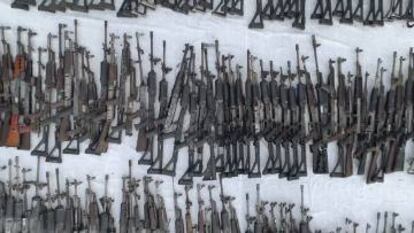
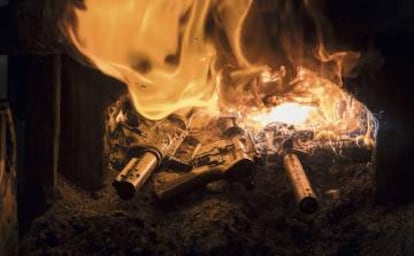
While Salcedo contemplates the pain of war as an artist, there are of course those in Colombia who experienced it firsthand and, aware of this, Salcedo invited 20 women who were subject to sexual slavery to participate in her project. “The collective has shaped the character of the work,” she says. “The response of these women was what I was hoping for. They felt they were helping to shape Colombian history. That’s how they talked about it. We’re speaking about extremely poor, marginalized women.”
In spite of her conversations with the victims, Salcedo says there is something she still does not understand. “I can’t get my head around the rape and abuse.” But this doesn’t frustrate her: “Art is just a way of failing better, if we are to quote Samuel Beckett. There are no triumphs – just ways of asking questions and picking at the threads to get a better understanding of reality.”
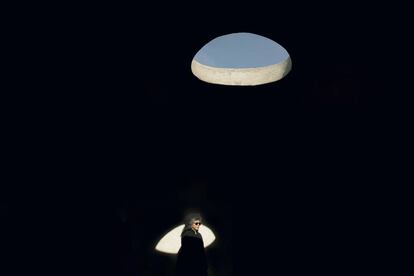
Eventually, Salcedo gave up putting herself in the skin of the aggressor, with all their irrational drive and senseless acts. “We can’t give it a meaning, which is why it is so dangerous,” she says.
She did, however, understand that the level of violence toward the victims is something that happens all around us on a daily basis, only we often choose not to see it. “Our ignorance is not innocent: we choose not to know instead of taking the lid off the rotting food in the pot.”
Involving the women was a way of flagging up these issues. “It’s showing how they manage in the most extraordinary way to keep going from day to day. Just sleeping at night is a huge achievement for them. Having breakfast without a panic attack, as well. Getting through the day and producing something is a feat. I wanted to shine some light on this blind spot.”
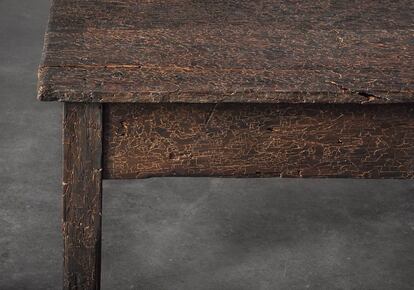
Besides Fragments, Salcedo has created other works inspired by the conflict, such as a simple reconstructed table called Tabula rasa. “I could see that I needed to break it up and put it back together again. It’s a metaphor for these women who have been murdered,” she says.
Salcedo typically works slowly, but Fragments required a different pace. In less than a year, she chose the space together with architect Carlos Granada, completed the design concept and got it done. The museum is located in a discreet street close to the presidential palace where a crumbling adobe building provides the diaphanous spaces, and where the ruins contrast starkly with the floor of melted weapons.
We’ve destroyed 37 tons of weapons through dialogue. We are capable of this. We don’t have to kill each other
Salcedo’s team of 30 worked relentlessly here alongside the 20 female victims of the conflict, each with a unique story of their own. “We should see how many versions we can come up with on the recent past,” she says. “We are dealing with a story that lacks balance, and that is the element that grew and generated more conflict. It dragged it out and made it more radical and filled with hatred. Colombia fell into the logic of the Cold War and a liberal guerilla army became a bastion of communism. It became more extreme, as did the army, and the distance grew between them until it became impossible for them to find each other.”
There were, says Salcedo, many factors at play. “Classism, racism, Colombian sexism; the struggles that generate marginalization,” she says. “Everyone rebelled against the center. Society starts excluding others and those who are deprived will always come back and take revenge. This is what fuels the conflict. The humanity of the other is not accepted.”
Salcedo believes that it is important now to focus on building peace. “There’s a risk it will break down,” she says, “but we’ve set a precedent. We’ve destroyed 37 tons of weapons through dialogue and we mustn’t forget that. We are capable of this. We don’t have to kill each other.”
Fragments could, however, cause its own share of controversy. “The FARC does not like the concept of Fragments,” says the artist. “They don’t want people to stand and contemplate their weapons, or explore their involvement in sexual violence. But our work is not to blame, it’s a forum that aims to encourage dialogue.”

Now that Fragments is finished, Doris is continuing with her mission, which is the constant examination of the pain and grief that has inspired her art over the years. “Mourning can only be conceived of within the context of armed conflict,” she says. “Natural death inspires something beautiful. It’s based on an element of comfort, it makes us human and gives us the chance to stop a person from disappearing. But what I am working on is the imposed death, the one that results from political violence that destroys life.”
Other artworks created by Salcedo have made a huge impact on the world, such as Shibboleth, an installation in the Turbine Hall of the Tate Modern, which consisted of a long crack in the floor. It was an allegory for racism, installed in a modern building that was constructed with money that has its origins in slavery.
“I thought I would bring who I am [to the commission],” says Salcedo. “And when I got there, to the museum of a slave owner who made his fortune from the plantations in Jamaica, I saw this crack. And something perverse and marvelous occurred to me that led to pointing out how this same building had been put up on the back of racism.”
Those running the Tate were divided on the issue and there was talk of dropping the commission, but in the end it went ahead and today the scar from the crack in the Turbine Hall can still be seen. “I had to break the museum,” says Salcedo. “It was necessary in order to show the wound and force them to look at the ground because we’re under it – the repressed – in the cultural heart of Europe.”
Artists should get involved in what they see and in its consequences
Salcedo did the same in the summer of 2017 in Madrid. When she won the Velázquez Prize in 2010, the Reina Sofia Museum commissioned an artwork. Again making a direct connection between the country of exhibition and the work itself, she turned her gaze on the Straits of Gibraltar, the stage for racism, inequality, abuse, anonymous deaths and the resulting grief. Out of this, she created Palimpsesto for the migrants who cross the Mediterranean in search of a better life. The names of hundreds of victims emerge momentarily on the surface of the work written in watery letters before disappearing again.
Her latest mission has taken her to Pennsylvania, where she has been working on a project inspired by the children who have been separated from their parents for attempting to come into the US over the Mexican border. “It’s the worst thing that has happened in the world since the separation of families in the Holocaust,” she says.
The recurrent themes of her work fill Salcedo with positive energy. “I feel as though I am on a mission,” she says. “There is so much scope, things to be done responsibly, starkly and with love. There is a lot to tell as a poetic and philosophical reflection because human beings are complex. Art should be layered and go beyond the original information to connect it to those contemplating it.”
Nihilism doesn’t come into it. “Art has the ability to act slowly. It lingers for centuries. I don’t get down. On the contrary, I feel the need to work more. I feel responsible in a country where violence comes at an unprecedented speed, though I haven’t experienced it directly. Artists should get involved in what they see and in its consequences. You can’t make the experience of the Holocaust end when the survivors die. The memory has to be kept alive.”
But that is not to say that Sacedo is not affected by the themes she works on. “There’s no way of avoiding it,” she says. “I have spent 30 years immersed in grief and surviving it. You can’t get out of the tunnel but you find heroes on the way, those that suffer cast light. They reaffirm life, these important, courageous beings who have so much to teach us. I can’t complain because nothing has happened to me. I just relate their stories dutifully. I listen and I try to be faithful to what I am told. Rather than a weight on my shoulders, don’t you think that is a gift?”
English version by Heather Galloway.

